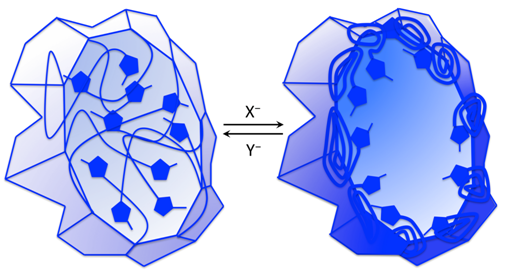报告题目:Stimuli Responsive Polymers for Advanced Dispersions and Materials
报告人:Prof. John Texter (Eastern Michigan University)
地点:907楼1101
时间:5月14日(星期三)下午2:00 - 3:00
欢迎感兴趣的老师和同学参加!
报告人简介:
John Texter教授现任Eastern Michigan大学 Distinguished Professor、聚合物与涂料研究所所长、苏州大学博彩平台
讲座教授。历任Journal of Dispersion Science and Technology杂志主编、Journal of Nanoparticle Research杂志副主编。Texter教授已在国际期刊发表学术论文200余篇。多次担任国际著名戈登会议(Gordon Research Conferences) 以及美国化学会分会主席。
Abstaract:
Stimuli responsiveness in polymer design is burgeoning and is providing basis for diversely new and advanced materials.1,2 These advanced materials include switchable porosity in membranes and coatings,3 switchable particle formation and thermodynamically stable nanoparticle dispersions,4 mechanicochemically-coupling polymers that provide directed mechanical stress in response to intensive fields,5,6 and switchable stabilization and compatibility of nanomaterials in changing environments, among others.7 The growth of ionic liquid applications and the concomitant incorporation of ionic liquids into polymeric materials have resulted in a plethora of new polymers based on the imidazolium group. Such polymers exhibit all of the above-articulated properties and can be distinguished as a class of cationic polyelectrolytes.1,2
In water and other solvents the interaction strength of various anions with the imidazolium group follows a Hofmeister series that imparts highly solvophilic character to highly solvophobic character depending on the particular anion-imidazolium ion-pair. We show that the dynamic range of these interactions spans 104 in concentration, and is the basis for tuning various stimuli responsive interactions. The most fundamental effect is how these interactions affect polymer solubility. Switching solubility from high to low forms a basis for advanced dispersion phase transfer. It also provides approaches to switching between transparent gels and open cell porous materials. These effects are shown to be applicable to the formation of thin films by nanolatexes, and that subsequently can be transformed into porous membranes. Another exciting application area is the incorporation of such imidazolium groups into block copolymers. Block copolymers8 and nanolatexes3 have been demonstrated to be excellent stabilizers for nanocarbons and other materials in water. When used by adsorption from solution, these nanolatexes behave as osmotic spheres and the triblocks as osmotic brushes; both classes of polymer are shown to immunize against Debye-Hückel charge screening induced coagulation. Particularly interesting are demonstrations that di-stimuli responsive diblocks can reversibly form thermodynamically stable dispersions.
The highly stable and concentrated nanocarbon dispersions in water are also shown to provide high performance new materials, including templated coatings with very high thermal conductivities (0.8 to 3 kW/m/K).9 Waterborne graphene dispersions are shown to form optical-rheological fluids that become light reflecting in shear fields. These graphene dispersions are also used to demonstrate a new type of deposition/coating process based upon the stimuli responsiveness of the stabilizing copolymer.
Fig. 1 Stimuli responsive pore gating
1.Yan, F; Lu, J; Texter, J. 2009. Advanced applications of ionic liquids in polymer science. Prog. Poly. Sci. 34, 431-448.
2.Texter, J. 2012. Anion responsive imidazolium-based polymers. Macromol. Rap. Com. 33, 1996-2014.
3.England, D; Tambe, N; Texter, J. 2012. Stimuli-responsive nanolatexes – Porating films. ACS Macro Lett. 1, 310-314.
4.Tauer, K; Weber, N; Texter, J. 2009. Core-shell particle interconversion with di-stimuli-responsive diblock copolymers. Chem. Commun. 45, 6065-6067.
5.Ma, X; Ashaduzzaman, Md; Kunitake, M; Crombez, R; Texter, J; Slater, L; Mourey, T. 2011. Stimuli responsive poly(1-[11-acryloylundecyl]-3-methyl-imidazolium bromide) – dewetting and nanoparticle condensation phenomena. Langmuir 27, 7148-7157.
6.Ma, X; Crombez, R; Ashaduzzaman, Md; Kunitake, M; Slater, L; Mourey, T; Texter, J. 2011. Polymer dewetting via stimuli responsive structural relaxation – Contact angle analysis. Chem. Commun. 47, 10356-10358.
7.Page, K; England, D; Texter, J. 2012. Capturing nanoscale structure in network gels by microemulsion polymerization. ACS Macro Lett. 1, 1398-1402.
8.Texter, J; Arjunan Vasantha, V; Maniglia, R; Slater, L; Mourey, T. 2012. Triblock copolymer based on poly(propylene oxide) and poly(1‐[11‐acryloylundecyl]-3‐methyl-imidazolium bromide). Macromol. Rap. Com. 33, 69-74.
9.Texter, J; Ager, D; Arjunan Vasantha, V; Crombez, R; England, D; Ma, X; Maniglia, R; Tambe, N. 2012. Advanced nanocarbon materials facilitated by novel stimuli-responsive stabilizers. Chem. Lett. 41, 1377-1379.

